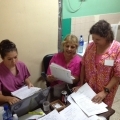Nicaragua 2012 trip diary: We can fix this
By Tina Romenesko
By 8:00 a.m, we were in the hotel lobby, wearing our scrubs and ready to go. We each made a name tag that could be easily pronounced by our Nicaraguan patients. Lezli, Catarina, Daniela, Lina… then made some adjustments. The hospital was crowded, inside and out, packed with people waiting to be seen. We moved through the non-air conditioned hallways, heading toward the air conditioned conference room to meet the Nicaraguan doctors, nurses, and residents. This is a teaching hospital, and some of the medical staff has worked with PINCC in the past three years, practicing to gain proficiency with the procedures to prevent cervical cancer.
The PAP test is also done here in Nicaragua, but the wait time to get a result often makes it ineffective for patients who travel long distances to get screened or are unable to complete a follow-up exam. The VIAA (visual inspection with acetic acid, which is white vinegar) is performed and completed in one visit making it a much more efficient screening procedure. If abnormal cells, areas, or lesions are detected, they are immediately removed and the client is sent home. All in one visit.
The data entry group was set up in a small room with numbered post-it notes and a big pile of charts. Their job is to organize the charts, get one of the interpreters to do the intake and then enter the data and prepare the file for the necessary screening and possible treatment plan.
I began by shadowing Sally as she interviewed a young mother. The questions were now clear for me, but answering them involved discerning heavy accents, deciphering the handwriting of numerous doctors and pathologists on previous tests, and then confiming all of the information, from medical history to current contact information, directly with the patient. The patience of the 3 women I interviewed was impressive. They were so helpful, and willing to repeat place names until I was able to understand and reproduce them onto the current form. Some patients waited for hours to be seen, in a non-airconditioned hospital corridor. I spent most of the afternoon in conversation with these women, helping them pass the hours and sharing life stories.
At the end of the day, I was pulled into an exam/procedue room to translate for Karen – one of the nurse practitioners. Half the time I was holding this very scared young woman´s hand and the other half of the time I was trying to parrot procedures I didn´t really understand. It felt a bit like channeling… ¨words like displasia, biopsia, cepillado, matriz, cuello uterino…. that I can barely understand in English. I was diligent to re-check what I couldn´t understand but it was by far the most intense translation experience of my life. We´ll see what days 2-5 bring….
The work day ended with an hour of sharing in the hotel lobby. I was impressed how everyone had an equal voice. These Doctors, Pam and Ilana, are completely capable, amazing, and present. Ana and Karen, the Nurse Practitioners are equally open, vulnerable, and interested in everyone´s commentaries. We saw 23 patients today and performed numerous life saving procedures. We talked about how to provide more privacy for patients. Issues with residents. How to deal with confusing data. Computer glitches. And the fact that this week numerous Nicaraguan doctors and nurses will be graduating to the role of eduacators.
“We can fix this” , said Carol to the group. “HPV is everywhere, but we can prevent cervical cancer with screening”. She reiterated that what we are doing is pure service. No glamour. Just damn hard work.
Over dinner the lines between PINCC and DFW faded completely. We had returned full circle to the yoga class the previous morning. Women helping women. Tomorrow. Day Two of the Medical Mission.

